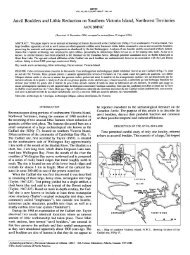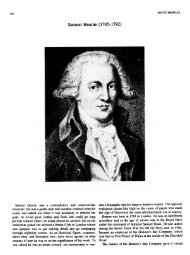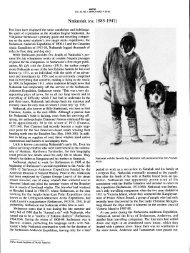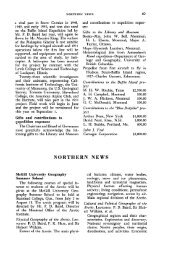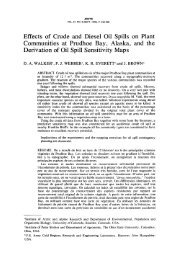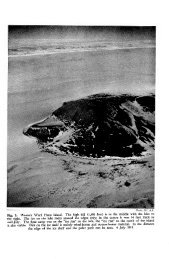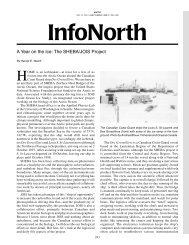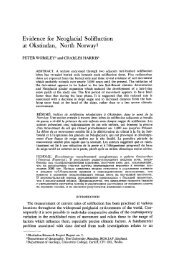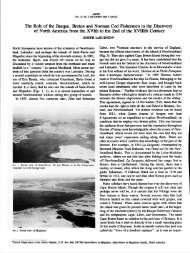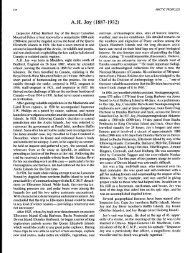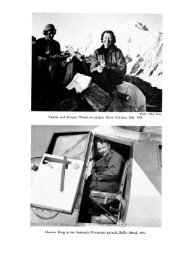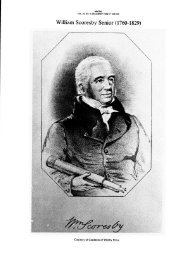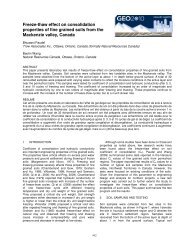NOTES ON THE NUNAMIUT ESKIMO AND MAMMALS OF ... - arctic
NOTES ON THE NUNAMIUT ESKIMO AND MAMMALS OF ... - arctic
NOTES ON THE NUNAMIUT ESKIMO AND MAMMALS OF ... - arctic
You also want an ePaper? Increase the reach of your titles
YUMPU automatically turns print PDFs into web optimized ePapers that Google loves.
162 <strong>THE</strong> <strong>NUNAMIUT</strong> <strong>ESKIMO</strong> <strong>AND</strong> <strong>MAMMALS</strong> <strong>OF</strong> <strong>THE</strong> ANAKTUVUK PASS REGI<strong>ON</strong><br />
are eaten by the Nunamiut. These larvae are often found in large numbers<br />
lying just below the skin on the back, and are eaten alive as they are removed<br />
from the small pocket of inflammatory tissue surrounding them.<br />
these larvae quite palatable.<br />
I have found<br />
Cooking, which has become a more common practice in later years, is<br />
done on small sheet-metal stoves. Maptigak, now an old man of about seventy<br />
years, stated that he was “old enough to hunt ptarmigan” before his family had<br />
ky stove other than the old fireplace (sinigun) outlined by a few stones on<br />
the floor. Cooking was done then in wooden vessels by adding heated stones.<br />
Larsen and Rainey (1948, p. 31), in discussing the “Nunatarmiut”, stated<br />
that: “When, for some unexplainable reason, the caribou fail to appear in<br />
numbers sufficient for their needs, the Nunatarmiut had the choice of starving<br />
or of settling on the coast until the herds returned.” This hardly appears to<br />
have been the case, since then, as now, they were capable of obtaining other<br />
animals in large enough quantity for survival. During the times of caribou<br />
shortage, the people eat ground squirrels, marmots, sheep, and fish. Bears are<br />
obtained from time to time, but never make up a very important part of the<br />
diet. When caribou are exceptionally scarce, the people may move to<br />
timbered regions where moose can be obtained in adequate numbers. The<br />
abundance of mammal life in the Brooks Range seems to ensure plentiful food,<br />
unless hunting success is prevented by a combination of unfavourable circumstances.<br />
Transportation<br />
The present-day Nunamiut have fine teams of unusually large and powerful<br />
dogs, some of which weigh more than 100 pounds. The Nunamiut have<br />
at times been criticized, by those unfamiliar with the conditions, for keeping<br />
large numbers of dogs, which naturally require a considerable amount of meat.<br />
However, large teams are needed to transport loads over terrain as difficult<br />
for dog team travel as that of the Brooks Racge outside the main valleys. On<br />
one trip over the mountains to the east, which I made with one of the Eskimo,<br />
we used ten dogs though we had almost no load, and sledding conditions were<br />
at their best. On fairly level ground, as in the main valley, about 100 pounds<br />
per dog is considered a suitable load. During the summer months, in the fall<br />
before freeze-up, and often on hunting trips in rough terrain, the dogs are<br />
used as pack animals. They are capable of carrying very heavy loads in<br />
pouches on either side of a caribou-hide pack saddle. I have seen a dog carry<br />
the entire fresh hide of an adult bull moose for a distance of more than two<br />
miles without showing undue signs of fatigue. Another dog carried a bear<br />
hide, which weighed slightly over 50 pounds, about ten miles through new<br />
snow, the bottoms of both pouches dragging deeply the entire distance.<br />
The Nunamiut sled has runners made of spruce, from trees obtained in the<br />
timbered regions to the south or to the east. A tree which has a pronounced<br />
curve just beneath the ground surface is felled and sawn lengthwise into boards.<br />
An entire section, after some shaping, is used for a runner, the bent end making<br />
the curved front,



